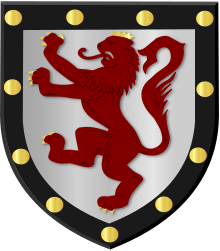Bergh (noble family)

The counts of the Bergh had their ancestral seat at Huis Bergh in what is now the Dutch town of 's-Heerenberg .
history
The series of Counts von dem Bergh began in the 11th century with Constantinus I de Monte from the House of Monte and then passed to the House of Von der Leck in 1416 . With Oswald I. von dem Bergh the family was then in 1486 by Emperor Friedrich III. awarded the title of imperial count.
Count Wilhelm IV of Bergh-'s-Heerenberg (1537–1586) is recognized by the witch hunt critic Johann Weyer (1515 / 16–1588) as an opponent of torture and the use of the death penalty. In 1581 he became governor of Gelderland and Zutphen within the newly founded Union of Utrecht , but was deposed after a few years because of his contacts with the Spanish side. He was married to Maria von Nassau-Dillenburg (1539–1599), the sister of Wilhelm von Orange (1533–1584).
Wilhelm IV's son Hermann von dem Bergh (1586–1611) made a career on the Spanish side and in 1593 became governor of Spanish funds . His sister Elisabeth von Bergh's-Heerenberg (1581-1614) was from 1605 to 1614 Abbess of food from and abbess in the pins Freckenhorst (since 1605) and Nottuln (since 1613). Another sister, Catherina von Bergh-'s-Heerenberg (1578-1640), was married to Floris II. Count zu Culemborg (1577-1639), lord of Pallandt.
In 1712 the county went to the House of Hohenzollern-Berg and in 1769 finally to the House of Hohenzollern-Sigmaringen .
Known family members
- Oswald I. von dem Bergh (1442–1511), ruling count of the Bergh
- Oswald III. von dem Bergh (1561–1586), officer during the Eighty Years War
- Elisabeth von Bergh-s'Heerenberg (1581–1614), abbess of the Essen monastery and abbess of other monasteries
- Maria Clara von Berg-s'Heerenberg (1635–1715), princess and regent of Hohenzollern-Sigmaringen
See also
literature
- Leopold von Ledebur : Nobility Lexicon of the Prussian Monarchy . Berlin 1854, Volume 1, pp. 50-51
- Gothaisches genealogical pocket book of the count's houses for the year 1865, p.134f Breda-Berg (S'Heerenberg)
Web links
Individual evidence
- ↑ "Comes Monte [n] sis Guilelmus"; see. Johann Weyer: De praestigiis daemonum et incantationibus ac veneficiis , Basel: Johann Oporinus successor 2nd ed. 1577, pp. 717f; Christoph Meiners : Historical comparison of the customs and constitutions, the laws and trades of trade and religion, the sciences and educational institutions of the Middle Ages with those of our century , Vol. III, Hannover: Helwing 1794, p. 368f.


